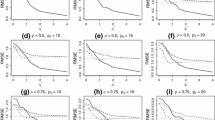Abstract
In this paper, we establish three identities which play a crucial role in deriving the asymptotic distributional risk function and the asymptotic distributional bias of a large class of estimators of a matrix parameter. In particular, we generalize the results in Judge and Bock (The statistical implication of pre-test and Stein-rule estimators in econometrics. North Holland, Amsterdam, 1978). The established results are useful in risk analysis of a class of Stein-rule type matrix estimators.
Similar content being viewed by others
References
Ahmed SE, Hussein A, Nkurunziza S (2010) Robust inference strategy in the presence of measurements error. Stat Prob Lett 80:726–732
Izenman AJ (2008) Modern multivariate statistical techniques: regression, classification, and manifold learning. Springer Science +Business Media, LLC, New York
Judge GG, Bock ME (1978) The statistical implication of pre-test and Stein-rule estimators in econometrics. North Holland, Amsterdam
Nkurunziza S (2012a) The risk of pretest and shrinkage estimators. Stat J Theor Appl Stat 46(3):305–312
Nkurunziza S (2012b) Shrinkage strategies in some multiple multi-factor dynamical systems. ESAIM Probab Stat 16:139–150
Nkurunziza S, Ahmed SE (2010) Shrinkage drift parameter estimation for multi-factor Ornstein-Uhlenbeck processes. Applied Stoch Models Bus Ind 26(2):103–124
Nkurunziza S, Ahmed SE (2011) Estimation strategies for the regression coefficient parameter matrix in multivariate multiple regression. Statistica Neerlandica 65(4):387–406
Sen PK, Saleh AKME (1987) On preliminary test and shrinkage M-estimation in linear models. Ann Stat 15(4):1580–1592
Saleh AKMd (2006) Theory of preliminary test and stein-type estimation with applications. Wiley, Hoboken
Acknowledgments
The author would like to acknowledge the financial support received from Natural Sciences and Engineering Research Council of Canada. Also, the author is thankful to anonymous referees for helpful comments.
Author information
Authors and Affiliations
Corresponding author
Appendix
Appendix
1.1 Proofs of Theorems 3.1 and 3.2
Proof of Theorem 3.1
Since \(\varvec{\Xi }_{1}^{\frac{1}{2}}\varvec{\Upsilon }\varvec{\Xi }_{1}^{\frac{1}{2}}\) and \(\varvec{\Xi }_{2}^{\frac{1}{2}}\varvec{\Lambda }\varvec{\Xi }_{2}^{\frac{1}{2}}\) are symmetric idempotent matrices, there exist orthogonal matrices \(\varvec{Q}_{1}\) and \(\varvec{Q}_{2}\) such that
Moreover, let \(\varvec{V}=\varvec{Q}_{1}\varvec{\Xi }_{1}^{\frac{1}{2}}\varvec{X} \varvec{\Xi }_{2}^{\frac{1}{2}}\varvec{Q}^{\prime }_{2}\). Then, \(\text{ Vec}\left(\varvec{V}\right)=(\varvec{Q}_{1}\varvec{\Xi }_{1}^{\frac{1}{2}}\otimes \varvec{Q}_{2}\varvec{\Xi }_{2}^{\frac{1}{2}})\text{ Vec}\left(\varvec{X}\right)\) and hence,
with
Therefore, from (5.2), \( \text{ trace}\left(\varvec{\Xi }_{2}\varvec{X}^{\prime }\varvec{\Xi }_{1}\varvec{\Upsilon }\varvec{\Xi }_{1}\varvec{X}\right) =\text{ trace}(\varvec{V}^{\prime }\varvec{Q}_{1}\varvec{\Xi }_{1}^{\frac{1}{2}} \varvec{\Upsilon }\varvec{\Xi }_{1}^{\frac{1}{2}}\varvec{Q}_{1}^{\prime }\varvec{V}) =\varvec{V}_{1}^{\prime }\varvec{V}_{1}.\) Hence, \(\text{ Vec}\left(\text{ E}\left[\phi \left( \text{ trace}\left(\varvec{\Xi }_{2}\varvec{X}^{\prime }\varvec{\Xi }_{1}\varvec{\Upsilon }\varvec{\Xi }_{1}\varvec{X}\right)\right)\varvec{X}\right]\right)= \text{ E}[\phi (\varvec{V}_{1}^{\prime }\varvec{V}_{1}\,) (\varvec{\Xi }_{1}^{-\frac{1}{2}}\varvec{Q}^{\prime }_{1}\otimes \) \( \varvec{\Xi }_{2}^{-\frac{1}{2}}\varvec{Q}^{\prime }_{2})\text{ Vec}(\varvec{V})]\) and then,
Also, from (5.2) and (5.3), \(\text{ E}\left(\varvec{V}_{2}\right)=\varvec{0}\) and \(\text{ Var}\left(\varvec{V}_{2}\right)=\varvec{0}\), so \(\varvec{V}_{2}\) is \(\varvec{0}\) with probability one, and then, \(\text{ E}\left[\phi \left(\varvec{V}_{1}^{\prime }\varvec{V}_{1}\,\right) \varvec{V}_{2}\right]=\varvec{0}\). Further, by using Theorem 1 in Judge and Bock (1978), we get
where \(\varvec{\mu }_{1}\) is given by (5.3). Using (5.1)- (5.3), \(\varvec{\mu }_{1}^{\prime }\varvec{\mu }_{1}=\text{ Vec}\left(\varvec{M}\right)^{\prime } \left(\varvec{\Xi }_{1}\varvec{\Upsilon }\varvec{\Xi }_{1}\otimes \varvec{\Xi }_{2}\right) \text{ Vec}\left(\varvec{M}\right)\), i.e.
Further, combining (5.4) and (5.5), we have
and then, \(\text{ Vec}\left(\! \text{ E}\left[\phi \left( \text{ trace}\left(\varvec{\Xi }_{2}\varvec{X}^{\prime }\varvec{\Xi }_{1}\varvec{\Upsilon }\varvec{\Xi }_{1}\varvec{X}\right)\right)\varvec{X}\right]\right)\!=\! \text{ Vec}\!\left(\!\text{ E}\left(\!\phi \left(\!\chi ^{2}_{pq_{1}\!+\!2}\left(\varvec{\mu }_{1}^{\prime }\varvec{\mu }_{1}\right)\right)\right)\varvec{M}\right)\), this completes the proof. \(\square \)
Proof of Theorem 3.2
From the above computations, we have \(\phi ( \text{ trace}(\varvec{\Xi }_{2}\varvec{X}^{\prime }\varvec{\Xi }_{1} \varvec{\Upsilon }\varvec{\Xi }_{1}\varvec{X})) \,{=}\, \phi (\varvec{V}_{1}^{\prime }\varvec{V}_{1})\). Further, as in Theorem 3.1, we have \(\varvec{V}=\varvec{Q}_{1}\varvec{\Xi }_{1}^{\frac{1}{2}}\varvec{X}\varvec{\Xi }_{2}^{\frac{1}{2}}\varvec{Q}^{\prime }_{2}\) where \(\varvec{Q}_{1}\) and \(\varvec{Q}_{2}\) are the same as in (5.1). We have \(\varvec{X}=\varvec{\Xi }_{1}^{-\frac{1}{2}}\varvec{Q}^{\prime }_{1}\varvec{V}\varvec{Q}_{2} \varvec{\Xi }_{2}^{-\frac{1}{2}}\) and hence,
Therefore, \(\text{ E}\left[\phi \left( \text{ trace}\left(\varvec{\Xi }_{2}\varvec{X}^\prime \varvec{\Xi }_{1}\varvec{\Upsilon }\varvec{\Xi }_{1}\varvec{X}\right)\right) \text{ trace}\left(\varvec{X}^{\prime }\varvec{A}\varvec{X}\right)\right]=\text{ E}[\phi \left(\varvec{V}_{1}^{\prime }\varvec{V}_{1}\,\right)\text{ trace}(\varvec{Q}_{1}\varvec{\Xi }_{1}^{-\frac{1}{2}} \varvec{A}\varvec{\Xi }_{1}^{-\frac{1}{2}}\varvec{Q}^{\prime }_{1}\varvec{V}\varvec{Q}_{2} \varvec{\Xi }_{2}^{-1}\varvec{Q}^{\prime }_{2}\varvec{V}^{\prime })]\). Also, we have \(\text{ trace} (\varvec{Q}_{1}\varvec{\Xi }_{1}^{-\frac{1}{2}} \varvec{A}\varvec{\Xi }_{1}^{-\frac{1}{2}}\varvec{Q}^{\prime }_{1}\varvec{V}\varvec{Q}_{2} \varvec{\Xi }_{2}^{-1}\varvec{Q}^{\prime }_{2}\varvec{V}^{\prime }) =\left(\text{ Vec}\left(\varvec{V}\right)\right)^{\prime } (\varvec{Q}_{1}\varvec{\Xi }_{1}^{-\frac{1}{2}} \varvec{A}\varvec{\Xi }_{1}^{-\frac{1}{2}}\varvec{Q}^{\prime }_{1}\otimes \varvec{Q}_{2}\varvec{\Xi }_{2}^{-1}\varvec{Q}^{\prime }_{2}) \text{ Vec}\left(\varvec{V}\right)\). Further, let
Therefore, \(\left(\text{ Vec}\left(\varvec{V}\right)\right)^{\prime } (\varvec{Q}_{1}\varvec{\Xi }_{1}^{-\frac{1}{2}} \varvec{A}\varvec{\Xi }_{1}^{-\frac{1}{2}}\varvec{Q}^{\prime }_{1}\otimes \varvec{Q}_{2}\varvec{\Xi }_{2}^{-1}\varvec{Q}^{\prime }_{2}) \left(\text{ Vec}\left(\varvec{V}\right)\right) =\varvec{V}_{1}^{\prime }\varvec{G}_{11}\varvec{V}_{1}. \) Further, using Theorem 2 in Judge and Bock (1978), we have
where
this completes the proof. \(\square \)
Rights and permissions
About this article
Cite this article
Nkurunziza, S. Extension of some important identities in shrinkage-pretest strategies. Metrika 76, 937–947 (2013). https://doi.org/10.1007/s00184-012-0425-5
Received:
Published:
Issue Date:
DOI: https://doi.org/10.1007/s00184-012-0425-5




